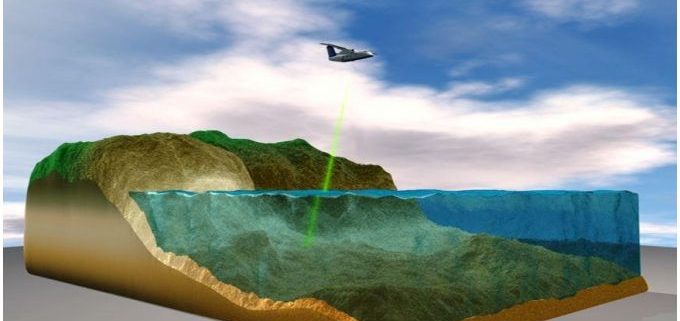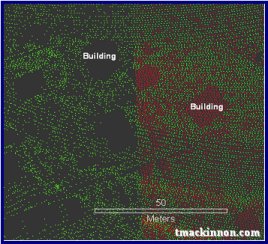LiDAR
Light Detection and Ranging
LiDAR is a remote sensing discipline that uses high precision GPS with an Inertial Measurement Unit (IMU) to determine accurate surface locations.

The resultant measurements consists of geographic locations that can be further processed to produce different spatial data products. I have worked in all aspects of LiDAR during my career, from data acquisition (with both airborne and terrestrial scanners) to processing and product creation. This section includes information on LiDAR with lots of samples and 3D images.
My experience using LiDAR began with the Applied Geomatics Research Group (AGRG) where I obtained an advanced graduate diplomas in applied geomatics research from Centre of Geographic Sciences (COGS). Later on in my career I was also fortunate to work in the LiDAR data acquisition industry, collecting data in helicopters, fixed wings, and terrestrial environments.
“Ground control points (GCP’s) are easily-identifiable markers on the ground of a jobsite that can be used to `georeference’ elevation models. This makes it possible to increase the absolute accuracy of drone data and create better deliverables like orthomosaics, point clouds, and more. ” ~ LiDAR Mag

Most LiDAR units are airborne types, so this next statement refers mainly to that type of LiDAR but I will also later on go into detail about Terrestrial LiDAR scanning as well. The unit uses a high precision Global Position System (GPS) and an Inertial Measurement Unit (IMU) to determine the location and measure the attitude of the aircraft so that the ground location of the return pulse can be accurately determined.
The LiDAR sensor produces a series of point measurements that consists of geographic location (X & Y) and height (Z) of both natural and man-made features, and can be further processed to produce several different products and integrated into a Geographic Information System (GIS).

Data produced from a LIDAR sensor in its most common form, is often represented by a series of spatial coordinates (or a 3D point cloud) in an American Standard Code for Information Interchange file (ASCII), or LAS file format. The LAS file format is a public file format for the interchange of LIDAR data between vendors and customers. This binary file format is an alternative to proprietary systems or the generic ASCII file interchange system used by many companies.
The data in the file is recorded in a tabular format where each line has coordinate information separated by a common delimiter. The data can include other attribute information for each point as well. There are additional ways to represent LIDAR data such as LAS format, which is an alternative to the generic ASCII file format used by many companies.
Resultant LIDAR data is usually a very dense network of coordinate points and can often contain millions of measurements for a given area. This can result into large file sizes, depending on the collection area and data resolution, which has been known to be difficult to handle with the majority of common off the shelf software packages. Continue to my 2004 LIDAR research project.
Much of the material in the Light Detection and Ranging part of my website originated from my original online portfolio that I used to further my career.
Since then it has morphed into more of a resources section related to remote sensing that includes helpful information about LiDAR, including various related books, images, maps, data and much more.
(Use the search tools to find remote sensing related material on this site or browse some of the latest additions using the links below).